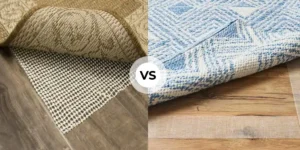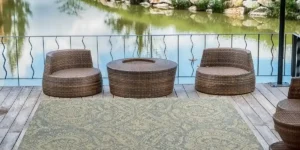Do you want to make your home stylish and comfortable? So, there is no doubt that you should choose the right flooring and rugs, which play a major role in your home.
If you have already installed vinyl flooring, then your tension is low. As we know, vinyl plank flooring has become quite popular in both homes and commercial spaces.
Well, rugs are there to bring a touch of warmth, comfort, and a welcoming vibe to your room. Also, it is available in a wide range of colors, patterns, and textures to suit any decor.
Well, now here is a question that arises: Can You Use Rubber Backed Rugs on Vinyl Plank Flooring?
No. Because using rubber-backed rugs on vinyl plank flooring can cause issues over time.
While vinyl plank flooring is generally resistant to damage from most common household items, certain rubber-backed or latex-backed rugs may have adverse effects.
We will explore the pros and cons of rubber-backed rugs and share some useful tips for maintaining vinyl flooring in this article.
What is a rubber-backed Rugs?
Rubber-backed rug means rugs with a rubber backing that is designed to prevent slipping on hard surfaces.
As a result, it can grip the floor better, thereby reducing the risk of it slipping. It makes them ideal for rooms with wood, tiles, or marble floors.
Can You Use Rubber Backed Rugs on Vinyl Plank Flooring?
Using rubber-backed rugs on vinyl plank flooring is generally not recommended. As it can lead to issues such as discoloration, staining, and potential damage to the flooring.
The rubber backing on some rugs may contain chemicals or dyes that can react with the vinyl over time.
Additionally, moisture trapped between the rubber backing and the vinyl can create conditions favorable for mold and mildew growth.
To protect your vinyl plank flooring and avoid these potential problems, consider the following alternatives:
- Non-Rubber-Backed Rugs: Opt for rugs with non-rubber or non-latex backings. Look for rugs labeled as safe for use on vinyl or hardwood floors.
- Rug Pads: Place a breathable rug pad between the rubber-backed rug and the vinyl plank flooring. Ensure that the rug pad is suitable for use on vinyl to prevent any adverse reactions. The pad should allow air circulation and prevent moisture from being trapped.
- Regular Cleaning: Keep the area clean and dry. Promptly clean up spills to prevent moisture from being trapped between the rug and the vinyl surface.
Pros and Cons of Rubber-Backed Rugs
Pros
- This rug is slip-resistant, reducing the chances of accidents.
- The price of the product is affordable and it is widely available.
- It is easy to clean and does not require a lot of maintenance.
- It is extremely durable and reliable.
- It is available in various shapes, sizes, and styles.
Cons
- Over time, it could discolor or damage the vinyl.
- A decrease in slip resistance can result in a need for replacement.
- It is not suitable for all types of flooring.
How to Choose the Best Rugs for Vinyl Plank Flooring?
To ensure that your vinyl flooring remains in good condition and is comfortable for you, you should consider some key factors.
Consider the Material:
When choosing rugs for vinyl flooring, material considerations are very important. You should choose rugs made from materials that are gentle on vinyl plank floors, such as cotton, jute, and polyester. These materials do not stain or damage easily.
Check the Backing:
Check the backing before buying the rug. Ensure the rug is non-slip backing. A non-slip backing helps prevent slips and falls.
It also keeps the rug in place and prevents it from shifting. Also, look for rugs with non-staining or non-marking rubber backing to minimize the discoloration risk.
Size Matters:
The next step is size matter. It is important to select a rug that fits the room’s size and your furniture’s style.
A rug that is too large or too small for the room can create an unbalanced appearance. Before buying a rug, it’s important to measure the room carefully to ensure that it looks perfect.
Low Pile or Smooth Weaves:
Well, it is a good idea to choose rugs with low piles or smooth weaves. Vinyl floors will be less likely to build up residue if you use these rugs since they trap less dirt and moisture.
Color and Styles:
To match the overall design of the room, the color and style of the rugs must be taken into consideration. In addition to protecting vinyl floors, a well-coordinated rug can enhance the aesthetics of your space.
Tips for Maintaining Vinyl Plank Flooring
- Regular Cleaning: You can keep your vinyl floors clean by vacuuming, sweeping, and mopping daily with a non-abrasive cleaner. Additionally, be sure to wipe up spills immediately to prevent damage or staining.
- Use Area Rugs: To protect the floor from wear and tear, place rugs or mats in high-traffic areas. It will keep your floor looking new and prevent scratches and stains. Rugs or mats will also help absorb sound and prevent slips and falls.
- Protect from Furniture: You can protect vinyl floors by using furniture pads under heavy furniture to prevent scratches and dents. Check the furniture pads regularly and replace them if they become damaged or worn.
- Keep Dry: Vinyl flooring is water resistant, but excessive water can seep into the seams and cause moisture issues. Moisture issues can cause the floors to warp, weaken, and discolor. To keep floors dry, it is important to mop and clean them regularly.
- Regular Maintenance: To prevent further damage, look for loose planks or seams and address them immediately. If any planks are loose, secure them with nails or screws. Also, look for cracks or holes that indicate damage.
Check Out More Related Floorings:
- Does Vinyl Flooring Fade in the Sun? (6 Ways to Prevent From Fading)
- Can I Use Laminate Flooring On Walls? (Installation Guide Included)
- 5 Best Ways to Remove Burn Marks From Vinyl Floors (Must-Try!)





